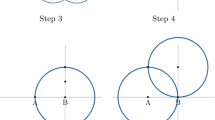Abstract
Whereas computer simulations involve no direct physical interaction between the machine they are run on and the physical systems they are used to investigate, they are often used as experiments and yield data about these systems. It is commonly argued that they do so because they are implemented on physical machines. We claim that physicality is not necessary for their representational and predictive capacities and that the explanation of why computer simulations generate desired information about their target system is only to be found in the detailed analysis of their semantic levels. We provide such an analysis and we determine the actual consequences of physical implementation for simulations.
Similar content being viewed by others
References
Chassaing, P. (2000). Turbulence en mécanique des fluides, analyse du phénomène en vue de sa modélisation à l’usage de l’ingénieur. Cepaduès Editions.
Cooley J.W., Tukey J.W. (1965) An algorithm for the machine calculation of complex Fourier series. Mathematics of Computation 19: 297–301
Farge M. (1986) L’approche numérique en physique. Philosophia Scientiae 7(2): 155–175
Hartmann S. et al (1996) The world as a process. Simulations in the natural and social sciences. In: Hegselmann R. (eds) Modelling and simulation in the social sciences from the philosophy of science point of view. Kluwer, Dordrecht, pp 77–100
Hartmann, S., & Frigg, R. (2006). Models in science. In E. N. Zalta (Ed.), Stanford encyclopedia of philosophy. Stanford University.
Hegselmann, R., Müller, U., & Troitzsch, K. (Eds.). (1996). Modelling and simulation in the social sciences from the philosophy of science point of view. Theory and Decision Library, Dordrecht: Kluwer.
Hughes R.I.G. (1999) The Ising model, computer simulation, and universal physics. In: Morgan M., Morrison M. (eds) Models as mediators. Perspectives on natural and social science. Cambridge University Press, Cambridge, UK, pp 97–145
Humphreys P. (1994) Numerical experimentation. In: Humphreys P. (eds) Patrick Suppes: Scientist Philosopher. Philosophy of physics, theory structure, and measurement theory (Vol. 2, 103/121). Kluwer, Dordrecht
Humphreys P. (2004) Extending ourselves. Computer Science, empiricism, and scientific method. Oxford University Press, Oxford
Lebanon, N. H. (1996). Fluent Europe: Computational fluid dynamics software. Fluent Inc.
Morgan, M., Morrison, M. (eds) (1999) Models as mediators. Perspectives on natural and social science. Cambridge University Press, Cambridge, UK
Norton S., Suppe F. (2001) Why atmospheric modeling is good science. In: Edwards P., Miller C. (eds) Changing the atmosphere. MIT Press, Cambridge, MA, pp 67–106
Pylyshyn Z. (1984) Computation and cognition. MIT Press, Cambridge, MA
Rohrlich, F. (1991). Computer simulations in the physical sciences. In A. Fine, M. Forbes, & L. Wessels (Eds.), PSA 1990 (Vol. 2, pp. 507–518). Philosophy of Science Association.
Winsberg E. (1999) Sanctioning models: The epistemology of simulation. Science in Context 12(2): 275–292
Winsberg E. (2001) Simulations, models and theories: Complex physical systems and their representations. Philosophy of Science (Proceedings) 68: S442–S454
Winsberg E. (2003) Simulated experiments: Methodology for a virtual world. Philosophy of Science 70: 105–125
Author information
Authors and Affiliations
Corresponding author
Additional information
A. Barberousse, S. Franceschelli and C. Imbert have contributed equally to this work.
Rights and permissions
About this article
Cite this article
Barberousse, A., Franceschelli, S. & Imbert, C. Computer simulations as experiments. Synthese 169, 557–574 (2009). https://doi.org/10.1007/s11229-008-9430-7
Received:
Revised:
Accepted:
Published:
Issue Date:
DOI: https://doi.org/10.1007/s11229-008-9430-7




